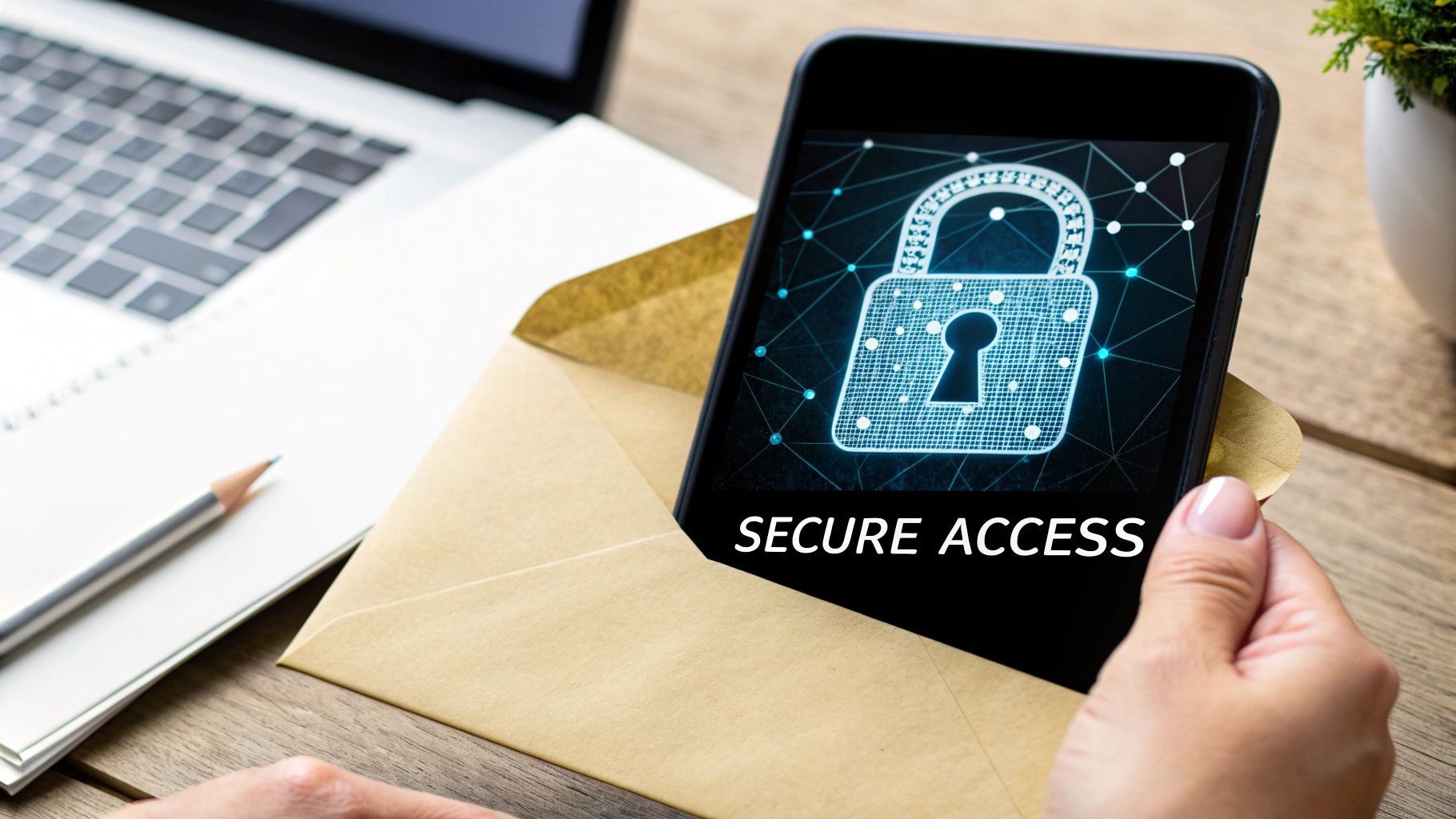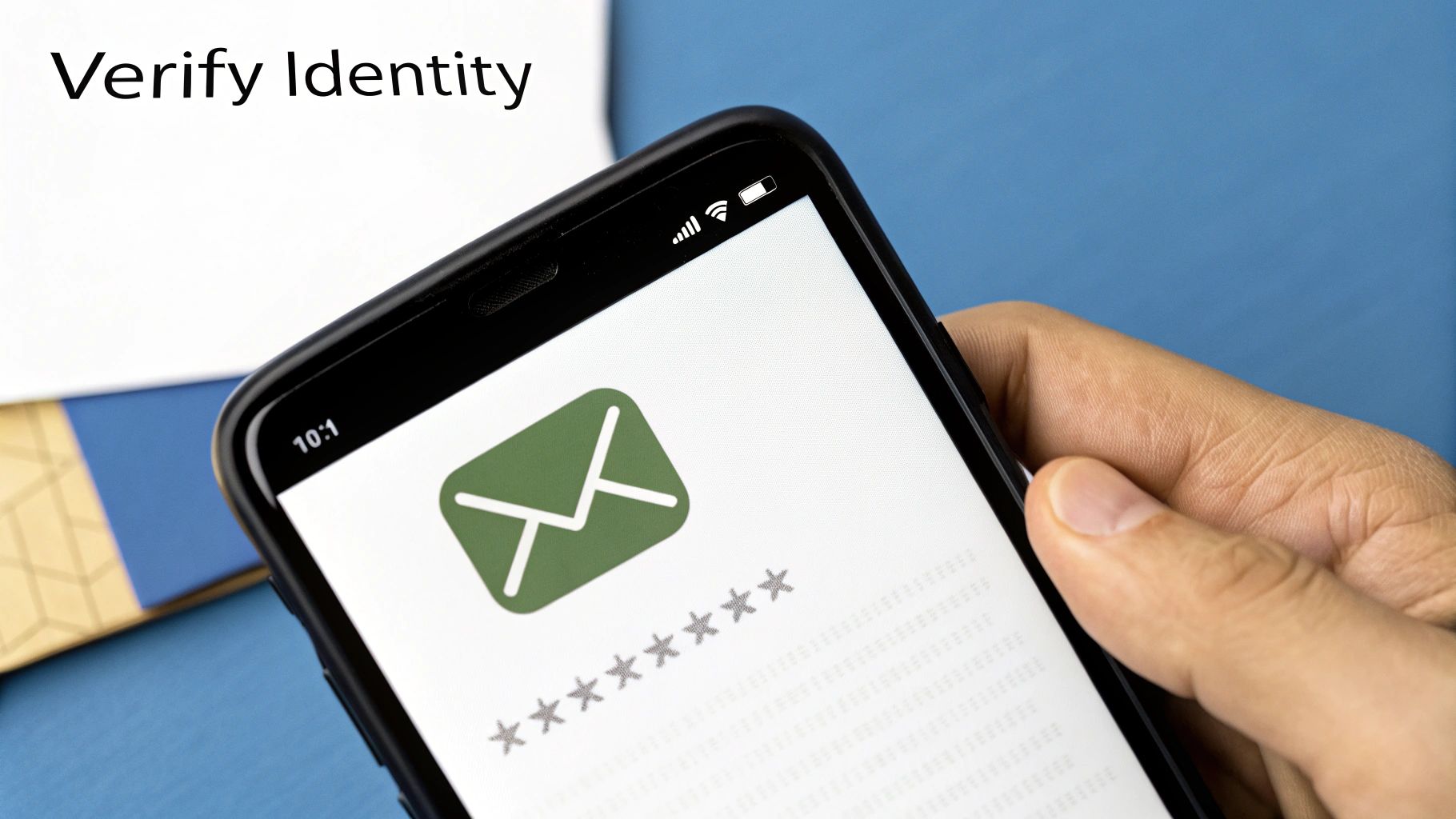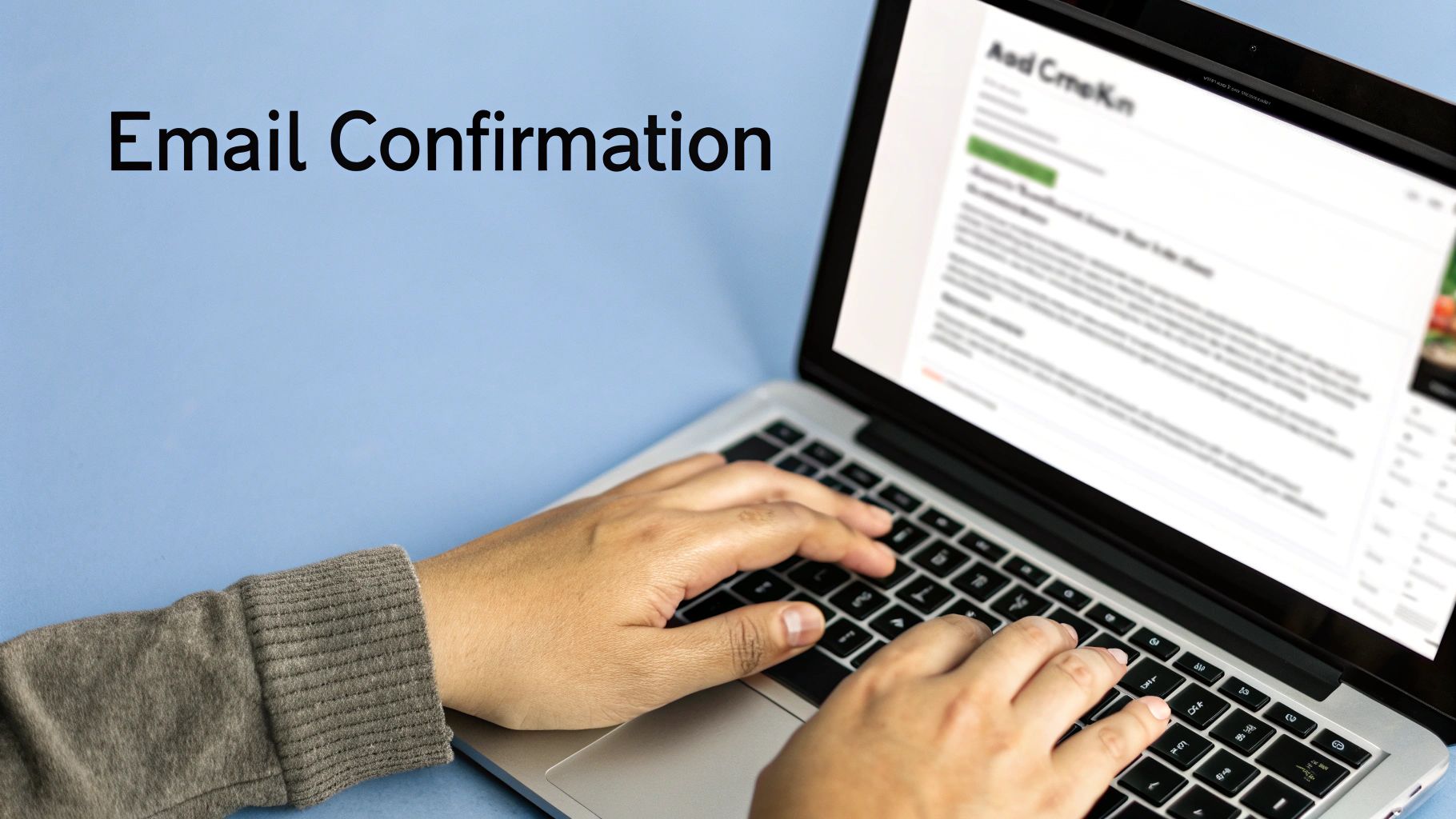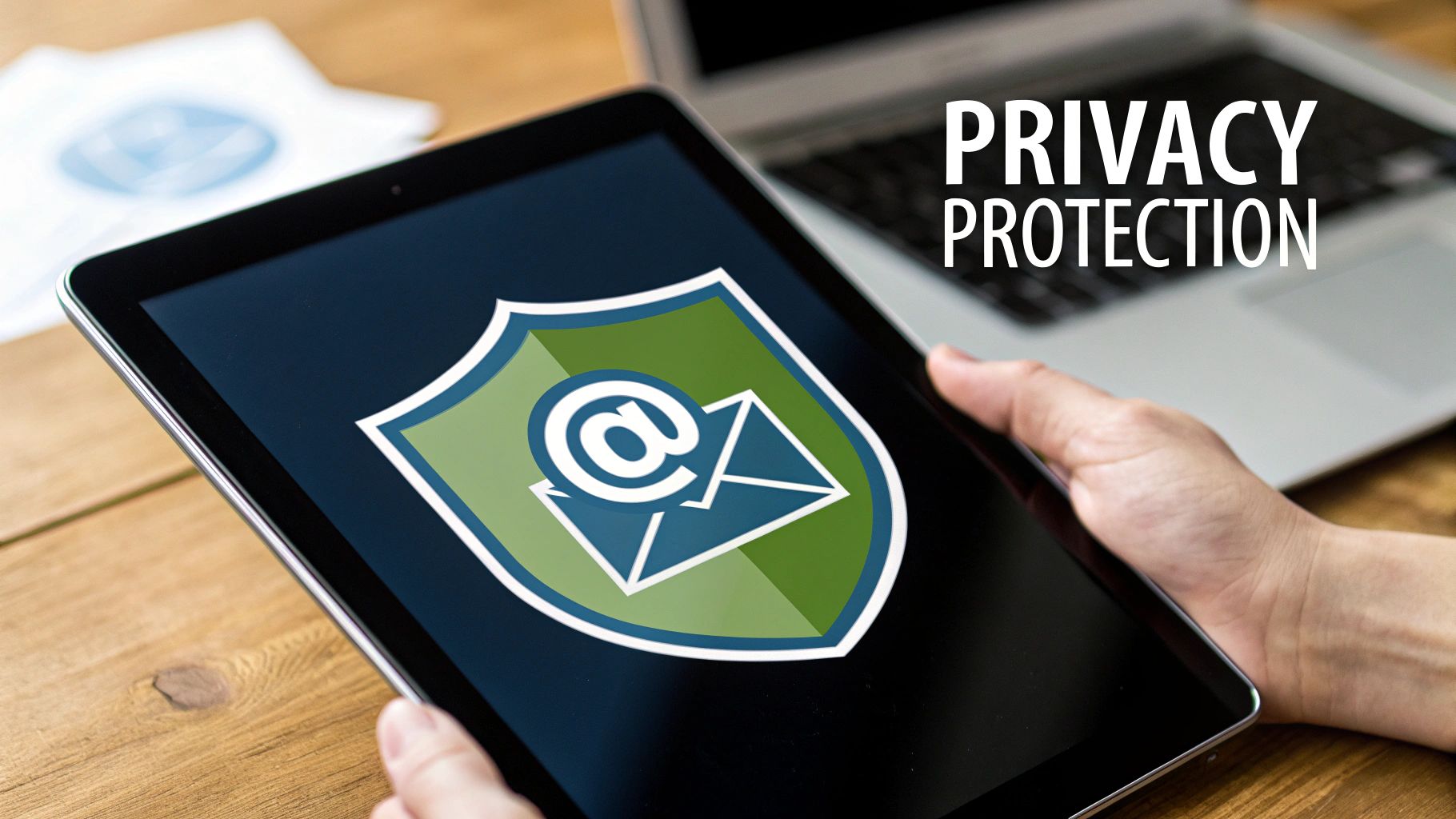Breaking Down Email Identity Verification Essentials
Email identity verification serves as the backbone of secure and reliable email communication. When implemented properly, it acts as a protective barrier that confirms emails originate from legitimate sources and safely reach their intended recipients. This essential process helps companies maintain customer trust, protect their reputation, and get better results from their email campaigns.
Core Components of Email Identity Verification
Email verification uses multiple checks to confirm both validity and authenticity. Let's examine the key elements that make up a complete verification system:
| Verification Component | Purpose | Impact on Security |
|---|---|---|
| Syntax Validation | Checks if email follows correct format ([email protected]) | Stops malformed addresses from entering systems |
| Domain Verification | Confirms domain exists and is active | Blocks addresses with fake or inactive domains |
| Mailbox Existence Check | Validates if mailbox exists at the domain | Prevents bounces by confirming address is live |
| Authentication Protocols | Uses SPF, DKIM, and DMARC to verify sender identity | Blocks spoofed emails and reduces spam/phishing |
These components create multiple layers of protection. While basic syntax checks catch obvious errors, deeper checks like mailbox verification ensure emails can actually be delivered. This multi-step approach provides the most complete security.
The Importance of Accurate Email Data
Clean, verified email lists are essential for any business that relies on email communication. Bad data directly impacts deliverability and campaign performance. Research shows that only 10% of collected email addresses are accurate, and just a 1% increase in bad addresses can reduce deliverability by 10%. See more statistics at LLC Buddy.
Using an email verification service like EmailAddress.ai helps protect your sender reputation and improves email deliverability rates. This lets you focus on engaging your audience and meeting your marketing goals. For more email verification resources, check out our sitemap.
The Hidden Impact of Verification Failures
When emails bounce, it's more than just a minor annoyance. Failed email verification has far-reaching effects that can seriously impact your business operations and bottom line. Understanding these often-overlooked consequences is essential for any organization that relies on email communications.
The Financial Fallout of Failed Verification
Poor email verification directly hits your marketing budget through wasted sends to invalid addresses. But the damage goes deeper – when too many emails bounce, your sender reputation takes a hit. Email providers may start marking your messages as spam, making it harder to reach real customers. This creates a costly cycle of reduced deliverability and lost opportunities.
The stakes are especially high when it comes to data security. Sending sensitive information to the wrong recipient due to verification failures can trigger legal issues and penalties. Recent data shows that in 2021, compromised email accounts led to $1.86 billion in consumer losses, while global fraud reached $5.38 trillion. See more data on these trends at IDScan's digital identity verification statistics.
The Erosion of Trust and Brand Reputation
Failed verification hurts more than your wallet – it damages how people view your brand. When your bounce rates climb, email providers take notice. Your messages may get flagged as spam, which makes recipients question your legitimacy. This loss of trust is difficult to rebuild and can drive away loyal customers.
Measuring and Monitoring the Impact
To manage verification risks effectively, you need to track key performance indicators. Focus on metrics like bounce rate, spam complaints, and deliverability rates. Regular monitoring helps catch problems early, enabling quick fixes before small issues become major setbacks.
Quantifying the ROI of Robust Verification
Using a reliable verification system like EmailAddress.ai pays off through better deliverability, protected sender reputation, and more effective campaigns. Be sure to check out How to master sitemaps for additional insights. Strong verification leads to higher engagement and conversion rates while building customer confidence in your brand. When you weigh the costs of verification failures against the benefits of proper verification, the smart choice becomes clear – invest in protecting your email communications.
Modern Verification Tools That Actually Work
Email identity verification goes beyond simple address format checks. It requires a multi-layered approach using several tools and methods to ensure accuracy. Let's explore the key technologies that help businesses improve email deliverability and protect their sender reputation.
AI-Powered Verification: The Intelligent Approach
Artificial intelligence brings new capabilities to email verification. AI tools analyze large datasets to spot fraudulent patterns that humans might miss. They can detect subtle signs of bot-generated accounts and adapt to new fraud tactics over time. This makes AI verification particularly effective at identifying disposable email addresses and other problematic accounts.
Machine Learning: Adaptive Verification
Machine learning systems work alongside AI to fine-tune verification in real-time. By continuously analyzing data about valid and invalid addresses, these tools get better at spotting fraud attempts. They monitor factors like sending patterns and user location to add extra security layers. This helps keep verification accurate even as email usage changes.
Let's compare the main verification approaches:
| Method | Accuracy | Implementation Complexity | Cost |
|---|---|---|---|
| Basic Syntax Check | 60-70% | Low | $ |
| AI-Powered | 95-98% | High | $$$ |
| Machine Learning | 90-95% | Medium | $$ |
| Behavioral Analysis | 85-90% | Medium | $$ |
Behavioral Analysis: Identifying Suspicious Patterns
Behavioral tools track how people use emails and web forms to spot potential fraud. They can trigger extra checks when they see warning signs like:
- Multiple accounts from one IP address
- Unusual login patterns
- Suspicious timing of activities
- Mismatched user locations
These insights help catch fraud that might slip past regular verification. For stronger security, many platforms check email deliverability, disposable email usage, and domain settings. A poorly configured domain often indicates fraud. Learn more about digital identity verification.
Choosing the Right Tool for Your Needs
When selecting verification tools, focus on your specific requirements:
- Expected email volume
- Security level needed
- Available budget
- Integration capabilities
EmailAddress.ai specializes in verifying business and consumer catch-all emails with 98% accuracy. This makes it ideal for organizations that need reliable deliverability. The right tool balances strong security with smooth operations. You might also be interested in: How to master sitemaps.
Building Your Verification Success Blueprint
Creating a solid email verification process takes careful planning. Let's walk through the key steps to build a verification system that works for your specific needs.
Developing Your Verification Framework
Start by getting clear on what you want to achieve. Ask yourself:
- Are you mainly focused on getting more emails delivered?
- Do you need to reduce fraud?
- Is protecting your sender reputation the priority?
Take stock of your current email practices – what verification methods do you use now? What are your bounce rates and spam complaints? Having this baseline helps track improvements.
Think through your available resources too. Consider your budget for tools and whether you have the team expertise to handle implementation, or if you'll need outside help.
Implementing Your Verification Strategy
With your plan ready, it's time for action. Choose an email verification service that fits your needs, offering features like real-time checks, bulk verification, and integration with your email platform. For example, EmailAddress.ai verifies business and consumer catch-all emails with 98% accuracy.
Update your systems by adding verification to signup forms, CRM, and email marketing tools. Make sure your team knows how to use the new verification processes and tools properly.
Optimizing Your Verification Process
Keep a close eye on key metrics after implementation:
- Bounce rates
- Spam complaints
- Email deliverability
If bounce rates stay high, you may need to adjust your approach. Review everything regularly – from verification rules to team training. Stay current with email verification best practices to keep your system working well.
Scaling Your Verification System
Make sure your verification can grow with your business. Consider:
- Processing speed for higher email volumes
- Data storage needs
- Integration with other business tools
- Data privacy rules in different regions
Having a solid verification blueprint helps protect your business and keeps emails reaching inboxes reliably. The right tools, like EmailAddress.ai, provide accurate verification to strengthen your email communication efforts.
When you focus on building a thoughtful, scalable verification process, you create a strong foundation for clean, deliverable email lists that drive results.
Next-Generation Email Identity Protection
Staying ahead of new email security threats requires a clear understanding of emerging technology and best practices. Here's a look at key developments that are making email verification more robust and reliable.
Blockchain-Based Verification: A New Approach to Security
Blockchain technology brings a fresh perspective to email identity management through its decentralized verification system. By recording verified email addresses on a public ledger, it creates an unbreakable chain of trust. Each email gets a unique cryptographic signature that proves its authenticity, making impersonation attempts nearly impossible.
Advanced Biometrics: Personal Identity Verification
Biometric authentication is changing how we prove who we are online. While fingerprint scanning is common today, facial recognition and voice authentication are becoming more prevalent in email security. Soon, accessing your email could be as simple as a quick face scan or voice command – making account security both stronger and more convenient.
AI-Driven Fraud Detection: Smart Defense Systems
Artificial intelligence is transforming how we detect email fraud. Modern AI systems process vast amounts of data to spot suspicious patterns that humans might miss. Like a vigilant security system, these tools continuously learn and adapt to new threats, stopping malicious emails before they reach your inbox.
Positioning Your Verification Strategy for the Future
To build a strong email verification system, focus on solutions that incorporate these new technologies effectively. For example, EmailAddress.ai achieves 98% accuracy in verifying business and consumer catch-all emails through advanced verification techniques. By staying current with security innovations, you can maintain reliable email communications while protecting against emerging threats.
Related: How to master sitemaps
Mastering Verification Implementation
Setting up email verification requires thoughtful planning and execution. Let's explore how to implement verification effectively while integrating it with your existing systems.
Planning Your Implementation
Start by defining clear goals for your verification system. Ask yourself: Are you trying to reduce bounces? Improve sender reputation? Prevent fraud? Having clear objectives will guide your implementation decisions.
Take stock of your current email setup – what platforms you use and how you collect addresses. Understanding your infrastructure helps ensure smooth integration. Consider whether your team has the technical skills needed or if you'll want outside help.
Step-by-Step Implementation Guide
Follow these key steps for a successful rollout:
- Pick Your Provider: Choose a verification service like EmailAddress.ai that matches your needs. Look for real-time checking, batch processing, and API access.
- Connect Your Systems: Link the verification service to your email platform, CRM, forms and other tools. This ensures automatic verification of all new addresses.
- Train Staff: Make sure your team knows how to use the new tools properly. Good documentation and training prevents mistakes.
Ongoing Optimization and Monitoring
Verification isn't "set it and forget it." Track important metrics like bounce rates, spam complaints and delivery success. Review these numbers regularly to spot issues early. For instance, if bounces suddenly increase, you may need to check your integration or adjust provider settings.
Troubleshooting Common Challenges
Watch out for these typical implementation hurdles:
- Integration Problems: Test thoroughly to ensure your verification service works with your tools. Verify the API connection before going live.
- Accuracy Issues: Some false results are normal. Work with your provider to fine-tune settings for better accuracy.
- User Experience: Keep verification simple. Use clear error messages and avoid complex processes that frustrate users.
Measuring Verification Effectiveness
Track key metrics before and after implementation to show the impact. For example, if bounce rates drop from 5% to 1%, that's a clear win you can share with stakeholders.
Following these guidelines helps you implement email verification successfully. The result? Better deliverability, stronger sender reputation, and less fraud.
Ready to start verifying emails accurately? Begin your verification journey with EmailAddress.ai today.





